Farmers to question legality of reduced rice tariff

MANILA, Philippines — Farmers will question the legality of the reduced tariffs on imported rice approved by President Marcos, former agriculture secretary Leonardo Montemayor said yesterday.
“We will consider filing a temporary restraining order in court, mobilizing for nationwide protest actions,” Montemayor told The STAR.
Farmers’ groups will meet this weekend to finalize their moves against the tariff cuts.
The National Economic and Development Authority (NEDA) Board chaired by Marcos approved on June 3 the new Comprehensive Tariff Program for 2024-2028, which includes the reduction of rice tariff for in- and out-quota rates from 35 to 15 percent.
Marcos lowered rice tariffs until 2028 to bring down rice prices to P29 per kilo, Socioeconomic Planning Secretary Arsenio Balisacan said earlier.
All safety nets for local farmers were removed by the tariff cuts and the prior issuance of Administrative Order 20, which removed non-tariff barriers on the importation of agricultural products, Montemayor said.
“There will be strong backlash (from) farmers (and) millers across commodities like rice, corn, pork and chicken. Almost all the tariff and non-tariff protection for agriculture, especially sensitive products, were removed,” he added.
The NEDA Board’s decision is not yet executory, he noted.
“It still needs an executive order to be signed by the President between now and the resumption of Congress on the last Monday of July. We are hoping that within this period, we can still appeal to the Department of Agriculture (DA), NEDA and the President to reconsider their decision,” Montemayor said.
The reduced rice tariff will not guarantee a decline in its retail price amid price increases in the international market and the depreciation of the Philippine peso against the dollar, he argued.
Farmers were not consulted by the DA nor the Tariff Commission before lowering the rice tariff, he noted.
“As a matter of normal procedure, the Tariff Commission holds hearings before the NEDA Board decides on the tariff cuts, but this did not happen,” he explained.
The farmgate price of palay will be affected by the flooding of imported rice, Montemayor said.
“Our estimate is that the losses to the farmers would reach P44 billion. Aside from this, the collection of the Bureau of Customs will also decrease. Our estimated forgone revenue for BOC is P15 billion, so all in all, the losses of farmers and the BOC will reach P60 billion (yearly),” he said.
Price monitoring
A watchdog group yesterday contradicted the DA’s monitoring that the prevailing price of rice ranged between P49 and P53 per kilo, saying that monitoring in Metro Manila markets is higher, between P54 and P64 per kilo.
“I went to the market and I saw P52 per kilo of rice, but the retailer admitted that while the price was the lowest in the market, the stock was limited and it was done as members of the media frequented the market,” Bantay Bigas spokesperson Cathy Estavillo said in a radio interview.
The landed cost of imported rice is P49 to P50 per kilo based on data, she noted.
This contradicted the government’s claim that the retail price of imported rice would go down by as much as P6 per kilo, she added.
As for the targeted P29 per kilo of rice, Estavillo said it is only available in certain Kadiwa stores.
P7 rice price drop uncertain
The projected drop in retail rice prices by as much as P7 per kilo may not fully materialize since it would depend on how much savings traders and retailers would pass on to consumers, experts said.
The government does not have any mechanism to ensure that importers and retailers would pass on to consumers their tariff savings, former agriculture secretary Emmanuel Piñol pointed out.
Premium-grade rice has been brought in by importers instead of the 25 percent broken variety affordable to the public, he noted.
Piñol proposed requiring half of importers’ shipments to be 25 percent broken rice, which would ensure the availability of affordable rice.
Imported rice stocks account for at least 20 percent of the country’s total staple supply since rice trading has been liberalized and deregulated in 2019.
The Philippine Statistics Authority earlier estimated that rice prices would drop by as much as P7 per kilo due to lower tariffs.
The DA earlier said it would seek congressional support for a higher National Food Authority budget to ensure it will purchase palay at a “reasonable price” and ensure farmers would profit.
Premium-grade rice is “not for the mass market,” said University of Asia and the Pacific-Center for Food and Agribusiness head Senen Reyes.
The retail price of imported 25 percent broken rice with a 15 percent tariff would be between P40 and P45 per kilo, he noted.
If imported supplies were of premium grade or five percent broken rice, then it would be more expensive, he said.
“How can you pull down (the market prices) if importers are bringing in the more expensive rice?” Reyes added.
Rice retailers may continue tracking prices being offered by the NFA as a factor in their final selling price, he said. As a rule of thumb, the price of rice is at least double the farmgate price of palay. – Jasper Emmanuel Arcalas, Ramon Efren Lazaro
- Latest
- Trending





























